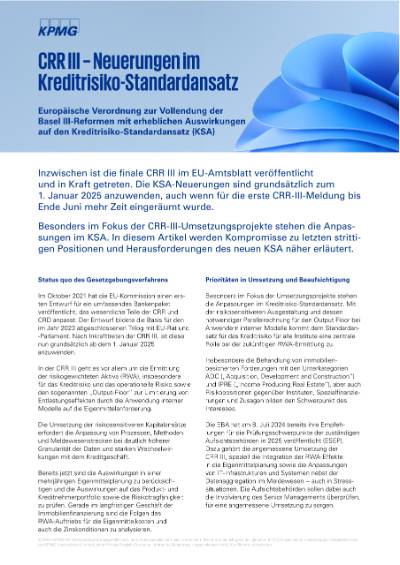The finalisation of the Basel III framework - known as Basel IV - is imminent: Already on 27 October 2021, the EU Commission presented the draft of an EU banking package, which is to implement Basel IV into European law with the CRR III (Capital Requirements Regulation), among others. The European Council (October 2022) and the European Parliament (January 2023) have also published their positions in the meantime, so that the final negotiations can start.
Basel IV is the collective term for regulatory innovations for the further development of the capital adequacy framework for banks in accordance with the specifications of the Basel Committee on Banking Supervision (BCBS). In addition to the general objective of ensuring financial stability, the finalisation of Basel III in the EU is also intended to strengthen the risk-based capital framework, focus on ESG risks and harmonise supervisory powers and instruments.
While CRR II still had a moderate impact on the calculation of RWA (risk-weighted assets), CRR III brings about significant changes in RWA and capital requirements. For European banks in particular, it means potential changes in profitability, in the design of individual products and their pricing, as well as in the implementation of significant requirements for IT and reporting solutions.
The most important changes for the institutions concern in particular the requirements for the calculation of RWA for credit risk, operational risk, CVA risk (Credit Valuation Adjustment) and partly market risk. The successive introduction of the so-called output floor, which limits the possible relief effects of users of internal models on RWA, is also coming into focus. In the future, they will have to apply all standard approaches in parallel to the internal models.
Thilo Kasprowicz
Partner, Advisory
KPMG AG Wirtschaftsprüfungsgesellschaft
Dr. David Nicolaus
Senior Manager, Financial Services
KPMG AG Wirtschaftsprüfungsgesellschaft
German banks particularly affected by the challenges
German banks in particular will be strongly affected by the above-mentioned changes, as many rely to a large extent on internal models and their exposure is often concentrated in areas with previously lower risk weightings. Accordingly, the revised standards can often result in higher capital requirements as well as high implementation costs for the institutions.
These include developing new methodologies to meet the new standards, complying with imposed disclosure requirements, and adapting systems and processes. Against the backdrop of strong competition within the industry and constant regulatory changes, institutions are facing major challenges overall - including integrating the effects into pricing.
Early familiarisation with the new regulations helps to assess the effects on risk-weighted assets and the resulting amount of regulatory capital that banks must hold under Basel IV. In particular, the internal processes in the banks and the interactions between the reporting units (including the reporting system) and the back-office and credit departments must be strengthened and expanded.
Our expertise
KPMG is in a market-leading position in providing implementation support for the Basel IV and CRR III requirements. We support our clients with detailed knowledge of Pillar 1 and Pillar 2 capital requirements and their interactions. Extensive experience in covering the broad range of topics and sound regulatory expertise (KPMG ECB Office) ensure tailor-made solutions for your house on the way to implementing the banking package.
We offer you established calculation and benchmarking tools from ongoing implementation projects for analysing potential effects from RWA changes and potential design decisions. In addition, we bring proven tools, methods and EU-wide implementation experience for the best possible success in ensuring your institution's reporting capability under CRR III in high quality – including technical adjustments to the delivery routes - into the reporting system.
Feel free to contact us at any time!
Insight and outlook
In the coming weeks, we will provide you with insights into the ongoing trilogue process and publish a series of further insights from our team of experts on various areas affected by the Basel standards. Our authors will be presenting their views on the challenges, expectations of supervisors and implementation measures.
Publication Series (In German only)
We are pleased to provide you with successive brochures on CRR III below.
Further Publications
Webcast
(in German only)
- Basel IV-CRR III – Sind Sie bereit - Einführung in das Bankenpaket 2021
- Basel IV-CRR III – Sind Sie bereit-Kreditrisiko_ Standard- und IRB-Ansätze
- Basel IV-CRR III – Sind Sie bereit-Marktrisiko, CVA und operationelles Risiko
- Basel IV-CRR III – Sind Sie bereit - Output Floor_ Gesamtbanksteuerung und -strategie
- Basel IV-CRR III - ESG-Risiken und Offenlegung-Meldewesen
Newsletter
(in German only)

Overall bank management incl. output floor
In order to reduce model risk and exploit design leeway, the so-called output floor is introduced. This limits the risk-weighted assets (RWA) calculated by the banks on the basis of internal models to a minimum percentage of 72.5% of the capital requirement calculated according to standard approaches. The gradual introduction of the output floor from 2025 onwards results in significantly higher minimum capital requirements, depending on how the institution is affected. The effects of the output floor can be mitigated through adequate mapping of the output floor in overall bank management and preparatory RWA optimisation measures.
Dr. David Nicolaus
Senior Manager, Financial Services
KPMG AG Wirtschaftsprüfungsgesellschaft

Standardised Approach Credit Risk (CRSA)
Due to the high dependence on external ratings, the lack of risk sensitivity and the lack of comparability to the IRBA asset classes, the CRSA was revised. However, its basic structure has been retained and is to be applied by all institutions due to the output floor rule. The new regulations include adjustments to the assignment of asset classes, changes in the risk weighting of real estate and special financing, among others, or simplifications of the CRMM framework. The effect on capital requirements varies greatly depending on the portfolio/business model and is associated with a variety of procedural challenges.
Your Contacts
Thilo Kasprowicz
Partner, Advisory
KPMG AG Wirtschaftsprüfungsgesellschaft
Christian Heichele
Partner, Financial Services
KPMG AG Wirtschaftsprüfungsgesellschaft

Internal Ratings Based Approach Credit Risk (IRBA)
In the course of the new framework, the scope of application of the internal credit risk models (IRBA) is significantly limited: For example, the use of the advanced IRB approach (A-IRB) is restricted with regard to certain asset classes (including specialised lending). In addition, the methods for estimating the IRBA model parameters will be limited. The elimination of the so-called exit threshold, on the other hand, also opens up the possibility for new users to benefit from internal models in Pillar 1 only for parts of the loan portfolio. Existing users can rethink their model landscape.
Your Contacts
Christian Heichele
Partner, Financial Services
KPMG AG Wirtschaftsprüfungsgesellschaft
Dr. Jürgen Ringschmidt
Partner, Financial Services, Head of Credit Risk Management & Validation
KPMG AG Wirtschaftsprüfungsgesellschaft

Operational risk (SMA)
The draft of a new framework for determining capital requirements for operational risks published by the Basel Committee in March 2016 replaces all previously existing measurement approaches. The new non-model-based calculation method (Standardised Measurement Approach, SMA) is intended to ensure comparability across all institutions. The relevant business indicator is derived from balance sheet and income statement items that reflect special features in commission, interest and trading business. Under the new standardised approach, loss data collection requirements only apply for disclosure purposes for institutions with a business indicator of >750 million euros.
Your Contacts
Markus Quick
Partner, Advisory
KPMG AG Wirtschaftsprüfungsgesellschaft
Daniela Klotzbach
Senior Managerin, Financial Services, Lead Specialist, Regulatory & Compliance
KPMG AG Wirtschaftsprüfungsgesellschaft

ESG: Disclosure and reporting
Within the framework of CRR III, ESG reporting and ESG disclosure are facing a comprehensive upheaval: new requirements standardise and expand the existing reporting to the supervisory authority and the public. From 2025, all institutions will have to publish qualitative and quantitative information on ESG risks and mitigating measures in specific disclosure and reporting forms. Further adjustments relate, for example, to the consideration of energy efficiency measures in the collateral of commercial and residential real estate. In addition, there will be more comprehensive disclosure requirements for exposures to companies operating in fossil fuel sectors.
Your Contacts
Thilo Kasprowicz
Partner, Advisory
KPMG AG Wirtschaftsprüfungsgesellschaft
Daniela Klotzbach
Senior Managerin, Financial Services, Lead Specialist, Regulatory & Compliance
KPMG AG Wirtschaftsprüfungsgesellschaft

Market risk (HB, CVA, FRBT)
With the implementation of Basel IV, the framework for determining CVA risks will be revised again from 2025. The basic and standard approaches will be renewed and counterparty credit spread risks and the market risk of the portfolio will be taken into account.
The new regulations within the framework of the Fundamental Review of the Trading Book (FRTB) also include a stricter separation of positions between the trading and banking book, the "arming" of a new standard approach for market price risks as well as revised regulations on the use of internal models.













